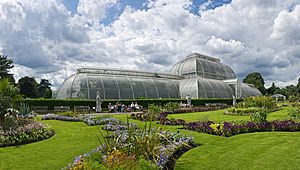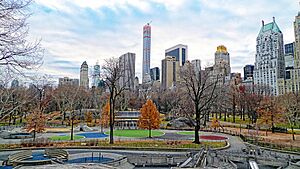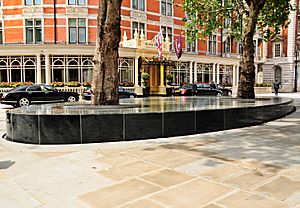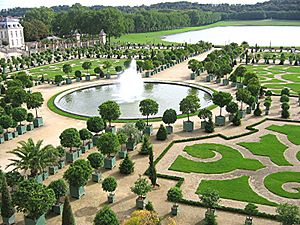Landscape architecture facts for kids
Landscape architecture is all about designing outdoor spaces. It's like being an architect, but for nature and public areas! Landscape architects create beautiful and useful outdoor places. They think about how people will use the space, how it affects nature, and how it looks.
This job involves studying the land, soil, and environment. They also consider how people use outdoor areas. Then, they design changes that make these spaces better.
Contents
What is Landscape Architecture?
Landscape architecture is a mix of many different subjects. It combines ideas from botany (the study of plants) and horticulture (growing plants). It also uses skills from fine arts, architecture, and even civil engineering.
Landscape architects work on all sorts of projects. They might design a new park or a botanical garden. They also plan outdoor spaces for schools or office buildings. Sometimes, they even help design parts of big roads or manage large natural areas.
They work with both "hard" materials like paths and buildings, and "soft" materials like plants and trees. A key goal is to make designs that are good for the environment. This means thinking about sustainability.
Landscape architects often start a project by coming up with big ideas. They create a main plan, like a blueprint for the outdoor space. Then, they make detailed drawings and plans for how everything will be built. They also check on the construction work to make sure it's done right.
What Do Landscape Architects Do?

Landscape architects work on many different types of projects. Here are some examples:
- Designing public parks and other public spaces.
- Creating plans for sustainable projects.
- Managing stormwater with things like rain gardens and green roofs.
- Designing outdoor areas for schools and government buildings.
- Planning botanical gardens, arboretums, and nature preserves.
- Designing fun places like playgrounds, golf courses, and theme parks.
- Creating landscapes for homes, industrial areas, and shopping centers.
- Adding plants and features along Highways and bridges.
- Helping with Urban design in cities, like town squares and waterfronts.
- Restoring historical gardens and natural parks.
- Working on big projects like dams or power stations. They help reduce the environmental impact.
- Studying the environment and landscape to help with planning.
- Designing green roofs for buildings. These roofs help manage water and keep buildings cool.
Some landscape professionals specialize in certain areas:
- Landscape managers help take care of landscapes over a long time. They often work in forestry or nature conservation.
- Landscape scientists use their knowledge of soil science or botany. They help solve problems in landscape work.
- Landscape planners focus on how land is used in cities, rural areas, and coasts. They create plans for new developments.
History of Landscape Architecture
Before the 1800s, landscape design was mostly about creating gardens for palaces and large homes. A famous example is the work by André Le Nôtre at the Palace of Versailles in France.
The term "landscape architecture" was first used in 1828 by Gilbert Laing Meason. John Claudius Loudon helped make the term popular.
This practice then spread to other parts of the world. In the United States, Frederick Law Olmsted used the title "landscape architect" in 1863. He is famous for designing Central Park in New York City.
In 1899, the American Society of Landscape Architects (ASLA) was founded. This helped establish landscape architecture as a formal profession.
Landscape Architecture and City Planning

In the 1800s, cities grew rapidly, and urban planning became very important. Landscape architecture combined traditional garden design with city planning needs.
Frederick Law Olmsted designed many important parks in the late 1800s. These include Central Park in New York City and Prospect Park in Brooklyn. These parks still influence landscape architecture today.
Another important figure was Beatrix Farrand. She was one of the first members of the American Society of Landscape Architects. She designed landscapes for many universities, like Princeton and Yale.
Over time, urban planning became its own separate job. However, landscape architects still work closely with urban planners.
In recent times, people like Ian McHarg brought environmental concerns into landscape architecture. He created a system to analyze different layers of a site. This system helped create today's Geographic Information Systems (GIS). GIS software is now used by many professionals to understand the Earth's surface.
Becoming a Landscape Architect
In many countries, there are special groups for landscape architects. These groups help protect the profession and support its members. In some places, you need a special license to work as a landscape architect. This ensures that professionals have the right education and experience.
For example, in the United States, landscape architects need a license from their state government. This usually means having a college degree, work experience, and passing a national exam. The US Bureau of Labor Statistics has even listed landscape architecture as a good job to have!
Images for kids
-
The National Mall in Washington, D.C.
-
A potager in Dordogne, France.
-
A Japanese garden in Ōtsu, Japan.
-
Topiary in Helsingborg, Sweden.
-
An Asian sculpture garden in Texas, United States.
-
A roof terrace garden in Ventimiglia, Italy.
-
Formal palace garden at El Escorial in Madrid, Spain.
-
A Mediterranean garden in Alpes-Maritimes, France.
-
Lurie Garden in Chicago, United States.
-
High Line (second section), a repurposed area in New York City, United States.
-
Schouwburgplein, an urban park in Rotterdam, Netherlands.
-
911 Memorial Park, a memorial park in New York City, United States.
See also
 In Spanish: Arquitectura del paisaje para niños
In Spanish: Arquitectura del paisaje para niños





















